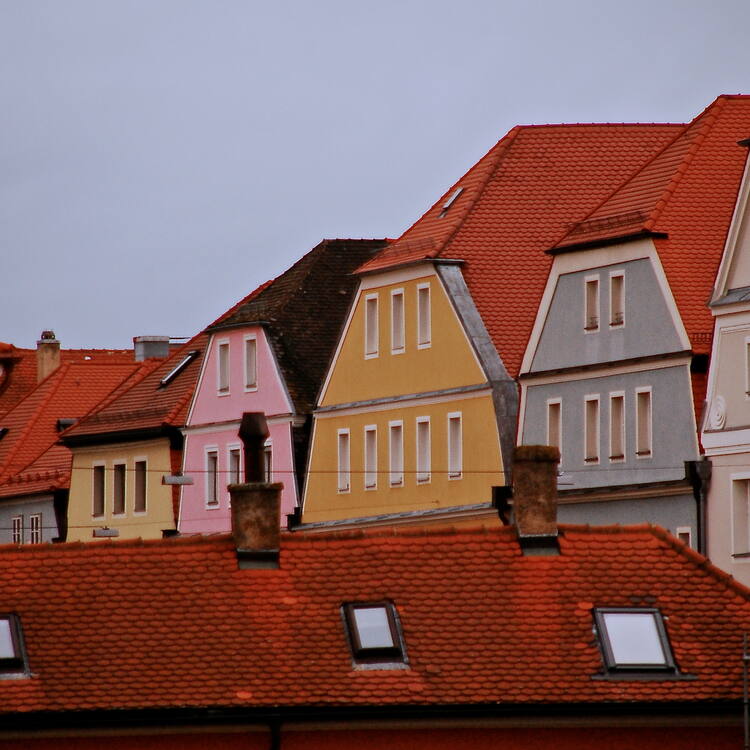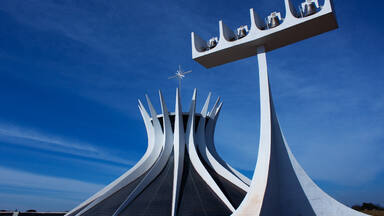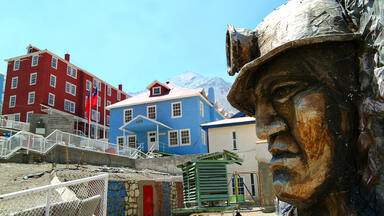Old town of Regensburg with Stadtamhof
Old town of Regensburg with Stadtamhof
Located on the Danube River in Bavaria, this medieval town contains many buildings of exceptional quality that testify to its history as a trading centre and to its influence on the region from the 9th century. A notable number of historic structures span some two millennia and include ancient Roman, Romanesque and Gothic buildings. Regensburg’s 11th- to 13th-century architecture – including the market, city hall and cathedral – still defines the character of the town marked by tall buildings, dark and narrow lanes, and strong fortifications. The buildings include medieval patrician houses and towers, a large number of churches and monastic ensembles as well as the 12th-century Old Bridge. The town is also remarkable for the vestiges testifing to its rich history as one of the centres of the Holy Roman Empire that turned to Protestantism.
Description is available under license CC-BY-SA IGO 3.0
Vieille ville de Ratisbonne et Stadtamhof
Située sur le Danube, cette cité médiévale de Bavière offre de nombreux bâtiments d’une qualité exceptionnelle qui témoignent de son passé de centre marchand et de son influence dans la région dès le IXe siècle. Elle a conservé une quantité notable de structures historiques couvrant deux millénaires, dont la période de la Rome antique ainsi que des édifices romans et gothiques. L’architecture des XI-XIIIe siècles - le Marché, l’Hôtel de ville, la Cathédrale – confère à Ratisbonne un caractère particulier : hauts édifices, ruelles étroites et sombres, murs d’enceinte très épais. Parmi les bâtiments, on trouve des tours patriciennes, un grand nombre d’églises et d’ensembles monastiques, ainsi que le Pont de pierre du XIIe siècle. La ville est aussi remarquable pour ses vestiges qui témoignent de sa riche histoire en tant qu’un des centres du Saint Empire romain germanique qui bascula vers le Protestantisme.
Description is available under license CC-BY-SA IGO 3.0
مدينتة رغنسبورغ القديمة وستادتامهوف
تقع هذه المدينة البافارية القروسطية على نهر الدانوب وهي تحوي الكثير من المباني ذات النوعية الاستثنائية التي تشهد على تاريخها كمركز تجاري وأثرها في المنطقة منذ القرن التاسع. لقد حافظت على كميّة كبيرة من البنى التاريخية التي تغطي ألفيتين، ومنها مرحلة روما القديمة كما وبعض المباني الرومانية والقوطية. وتعطي الهندسة المعمارية التي تعود إلى القرنين الحادي عشر والثالث عشر -ومنها السوق والبلدية والكاثدرائية- رغنسبورغ طابعاً مميزاً بالمباني العالية والشوارع الضيقة والمظلمة والجدران المحيطة السميكة. ونجد بين المباني بعض الأبراج الخاصة بالنبلاء القدامى، كما وعدداً كبيراً من الكنائس والمجمّعات الرهبانية بالإضافة إلى جسر الحجر الذي يعود إلى القرن الثاني عشر. وتتميّز المدينة أيضاً بآثارها التي تشهد على تاريخها الغني كأحد المراكز الخاصة بالإمبراطورية الرومانية المقدسة الجرمانية التي تحوّلت إلى البروتستانتية.
source: UNESCO/CPE
Description is available under license CC-BY-SA IGO 3.0
德国多瑙河畔“雷根斯堡旧城”
雷根斯堡旧城位于多瑙河畔,属巴伐利亚州。这座中世纪城市里有许多杰出的建筑,见证了雷根斯堡作为贸易中心的历史,也见证了这座城市在9世纪时对这一地区所产生的影响。雷根斯堡保存了数量众多的历史建筑,包括古罗马建筑、罗马式建筑及哥特式建筑,这些建筑跨越了近两千年的岁月。11至13世纪的建筑,包括市场、市政厅和教堂,至今仍是雷根斯堡的特色,到处是高高耸立的建筑、昏暗狭窄的街道,还有固若金汤的堡垒。这些建筑物中有中世纪贵族的房屋和塔楼、许许多多的教堂和修道院建筑群,还有建于12世纪的古桥。这座城市的著名之处还在于其许多遗迹都展现了这里浑厚的教育和宗教历史。这里曾是神圣罗马帝国的中心之一,后又转奉新教。
source: UNESCO/CPE
Description is available under license CC-BY-SA IGO 3.0
Старый город в Регенсбурге, включая район Штадтамхоф
В этом средневековом городе, расположенном на берегах Дуная в Баварии, находится множество замечательных зданий, являющихся свидетельствами его истории, как важного торгового центра, влиявшего на соседние районы, начиная с IХ в. Здесь сохранились исторические сооружения, относящиеся к почти двухтысячелетнему периоду, включая древнеримские, романские и готические здания. Архитектурные памятники Регенсбурга ХI-ХIII вв., включающие рынок, ратушу и кафедральный собор, все еще определяют облик города, с характерными для него высокими зданиями, темными узкими переулками и мощными укреплениями. Среди зданий средневековые дома патрициев с башнями, множество церквей и монастырских ансамблей, а также Старый мост, относящийся к ХII в. Сохранились многие свидетельства насыщенной общественной и религиозной жизни этого города, являвшегося одним из тех центров Священной Римской империи, которые обратились к протестантизму. Штадтамхоф – это район на противоположном, по отношению к Старому городу, берегу Дуная, где находится исторический комплекс бывшей больницы Св. Екатерины.
source: UNESCO/CPE
Description is available under license CC-BY-SA IGO 3.0
Centro histórico de Ratisbona y Stadtamhof
Situada en Baviera, a orillas del Danubio, esta ciudad medieval posee numerosos edificios de calidad excepcional que atestiguan su pasado de influyente centro mercantil de la región desde el siglo IX. Ratisbona ha conservado numerosos monumentos de su historia bimilenaria como construcciones romanas y edificios románicos y góticos. La arquitectura de los siglos XI a XIII –periodo en el que se construyeron el mercado, el ayuntamiento y la catedral– confiere a la ciudad un carácter singular: edificios altos, calles estrechas y oscuras, murallas muy anchas. Entre los edificios hay también torres señoriales y múltiples iglesias y monasterios, así como un puente de piedra del siglo XII. La ciudad es también famosa por vestigios que dan cuenta de su rica historia como uno de los centros del Sacro Imperio Romano Germánico que abrazó el protestantismo.
source: UNESCO/CPE
Description is available under license CC-BY-SA IGO 3.0
レーゲンスブルクの旧市街とシュタットアムホーフ
バイエルン地方のドナウ河畔に位置するレーゲンスブルクには、古代ローマ時代の要塞からロマネスク様式、ゴシック様式に至るまで、2000年の歴史を示す建造物が保存されている。なかでも、商業の中心地として発展し、周囲に影響をもたらした9世紀の建造物の保存状態はきわめて良好だ。加えて、ドイツに現存する最古の石橋、旧市庁舎、大聖堂など11~13世紀の建築物も、中世都市の特色を今に伝えている。また、プロテスタントに転じた神聖ローマ帝国の中心都市の一つとして、宗教史上にもその痕跡を残す。ドナウ川の対岸、旧・聖カタリーナ慈善病院の建つシュタットアムホーフ地域も、同時に世界遺産に登録された。source: NFUAJ
Oude stad van Regensburg met Stadtamhof
Regensburg ligt aan de Donau in Beieren. De middeleeuwse stad heeft veel gebouwen die getuigen van haar geschiedenis als handelscentrum en van haar invloed in de regio vanaf de 9e eeuw. Een groot aantal historische bouwwerken omspant zo’n twee millennia, waaronder oude Romeinse, romaanse en gotische gebouwen. De 11e tot 13e-eeuwse architectuur van Regensburg – onder andere de markt, het stadhuis en de kathedraal – bepaalt nog steeds het karakter van de stad, gekenmerkt door hoge gebouwen, donkere en smalle steegjes en sterke vestingwerken. Een van de kenmerkende bouwwerken is de Oude Brug, gebouwd in de 12e eeuw.
Source: unesco.nl
Outstanding Universal Value
Brief synthesis
Located on the Danube River, the Old Town of Regensburg with Stadtamhof is an exceptional example of a central-European medieval trading centre, which illustrates an interchange of cultural and architectural influences. The property encompasses the city centre on the south side of the river, two long islands in the Danube, the so-called Wöhrde (from the old German word: waird, meaning island or peninsula), and the area of the former charity hospital St Katharina in Stadtamhof, a district incorporated into the city of Regensburg only in 1924. A navigable canal, part of the European waterway of the Rhine-Main-Danube canal, forms the northern boundary of Stadtamhof.
A notable number of buildings of outstanding quality testify to its political, religious, and economic significance from the 9th century. The historic fabric reflects some two millennia of structural continuity and includes ancient Roman, Romanesque, and Gothic buildings. Regensburg's 11th to 13th century architecture still defines the character of the town marked by tall buildings, dark and narrow lanes, and strong fortifications. The buildings include medieval Patrician houses and towers, a large number of churches and monastic ensembles as well as the 12th century Stone Bridge.
The town is also remarkable as a meeting place of Imperial Assemblies and as the seat of the Perpetual Imperial Diet general assemblies until the 19th century. Numerous buildings testify to its history as one of the centres of the Holy Roman Empire, like the Patrician towers, large Romanesque and Gothic church buildings and monasteries – St Emmeram, Alte Kapelle, Niedermünster and St Jakob - as well as the cathedral St Peter and the late Gothic town hall.
Criterion (ii): The architecture of Regensburg represents the city's role as a medieval trading centre and its influence in the region north of the Alps. Regensburg was an important transition point on continental trade routes to Italy, Bohemia, Russia and Byzantium. It also had multiple connections with the transcontinental Silk Roads. As such, the city exhibits an important interchange of cultural and architectural influences, which have shaped its urban landscape.
Criterion (iii): The Old Town of Regensburg bears an exceptional testimony to cultural traditions especially in the Holy Roman Empire, being the location for most of the assemblies of the Empire in the High Middle Ages. Regensburg also significantly contributed to more recent European history being the seat of the Perpetual Assembly from 1663 to 1806. As a testimony to these functions, there are the remains of two imperial Palatine palaces from the 9th century, and a large number of other well preserved historic buildings, which are testimony to the wealth and political importance of the community.
Criterion (iv): The Old Town of Regensburg with Stadtamhof is an outstanding example of a central-European medieval trading town, which has well preserved its historical stages of development, and which is an exceptional illustration to the development of commerce particularly from the 11th to 14th centuries.
Integrity
Regensburg's Old Town has been able to reserve its original medieval outline since the 14th century. The Old Town survived the Second World War in exceptionally good shape. As a result, but also due to restoration efforts starting in the 1970s, a large number of old buildings have been preserved well, which contributes to the historical integrity of the town and the effective protection of important views of the property. The property therefore contains all elements necessary to express the Outstanding Universal Value. There are no adverse impacts of development and/or neglect.
Authenticity
Taking into account that the city was built in stone, rather than timber, the individual listed buildings have maintained their authenticity. The restoration of the buildings is carefully monitored and correctly carried out, according to the legal provisions in place as well as respecting the historic fabric.
Management and protection requirements
The Old Town of Regensburg and its buffer zone have been legally protected since 1975 in accordance with the Bavarian Law for the Preservation of Historic Buildings. The inscribed property is also ruled by the 1982Statutes concerning Local Building Ordinances for the Protection of the Old Town of Regensburg ("Old Town of Regensburg Statutes"). The Federal Building Code (1986/1997) constitutes the legal basis for construction and development planning. Complemented by local by-laws and the management plan, this complex system of protection ensures the good state of conservation of the property.
Several institutions on communal and state level share the responsibility for protecting the property. The City of Regensburg is responsible for its management. The Steering Committee carries out integrative monitoring as a basis of a thorough planning process and sustainable development in the historic town, with due care being taken to ensure that its values are respected. Strategies aim at restoring the historic urban fabric as well as strengthening the vitality of the inhabited historic town.






